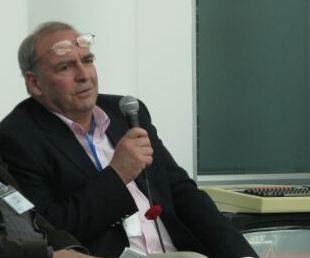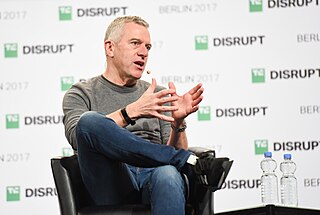This article needs additional citations for verification .(February 2010) |
The Olivetti Research Laboratory (ORL) was a research institute in the field of computing and telecommunications founded in 1986 by Hermann Hauser and Andy Hopper.
This article needs additional citations for verification .(February 2010) |
The Olivetti Research Laboratory (ORL) was a research institute in the field of computing and telecommunications founded in 1986 by Hermann Hauser and Andy Hopper.
When Olivetti acquired Acorn Computers in 1985, Hauser, who was Acorn's co-founder, became vice-president for research at Olivetti where he was in charge of laboratories in the US and Europe. In 1986, Hauser co-founded the Olivetti Research Laboratory (ORL) in Cambridge, England, along with Professor Andy Hopper. Hopper became the laboratory's Director.
In 1988, Hauser left Olivetti. In 1997 the lab became the Olivetti & Oracle Research Lab. In January 1999 it was acquired by AT&T Corporation and became AT&T Laboratories Cambridge.
AT&T Laboratories Cambridge was for three years Europe's leading communications engineering research laboratory. The laboratory was internationally recognised as a centre of excellence, undertaking advanced research into communications, multimedia and mobile technologies.
As a result of heavy losses, AT&T restructured its worldwide research efforts and the Cambridge labs closed on 24 April 2002.

Bell Labs is an American industrial research and scientific development company. Researchers from there are credited with the development of radio astronomy, the transistor, the laser, the photovoltaic cell, the charge-coupled device (CCD), information theory, the Unix operating system, and the programming languages B, C, C++, S, SNOBOL, AWK, AMPL, and others. Ten Nobel Prizes and five Turing Awards have been awarded for work completed at Bell Laboratories.

A local area network (LAN) is a computer network that interconnects computers within a limited area such as a residence, school, laboratory, university campus or office building. By contrast, a wide area network (WAN) not only covers a larger geographic distance, but also generally involves leased telecommunication circuits.

Acorn Computers Ltd. was a British computer company established in Cambridge, England, in 1978. The company produced a number of computers which were especially popular in the UK, including the Acorn Electron and the Acorn Archimedes. Acorn's BBC Micro computer dominated the UK educational computer market during the 1980s.

The Cambridge Ring was an experimental local area network architecture developed at the Computer Laboratory, University of Cambridge starting in 1974 and continuing into the 1980s. It was a ring network with a theoretical limit of 255 nodes, around which cycled a fixed number of packets. Free packets would be "loaded" with data by a sending machine, marked as received by the destination machine, and "unloaded" on return to the sender; thus in principle, there could be as many simultaneous senders as packets.

Virtual Network Computing (VNC) is a graphical desktop-sharing system that uses the Remote Frame Buffer protocol (RFB) to remotely control another computer. It transmits the keyboard and mouse input from one computer to another, relaying the graphical-screen updates, over a network.

The Department of Computer Science and Technology, formerly the Computer Laboratory, is the computer science department of the University of Cambridge. As of 2023 it employed 56 faculty members, 45 support staff, 105 research staff, and about 205 research students. The current Head of Department is Professor Alastair Beresford.

IBM Research is the research and development division for IBM, an American multinational information technology company headquartered in Armonk, New York, with operations in over 170 countries. IBM Research is the largest industrial research organization in the world and has twelve labs on six continents.

Silicon Fen or the Cambridge Cluster is the name given to the region around Cambridge, England, which is home to a large number of high tech businesses focused on software, electronics, and biotechnology, including Arm and AstraZeneca.

Hermann Maria Hauser, KBE, FRS, FREng, FInstP, CPhys is an Austrian entrepreneur, venture capitalist and inventor who is primarily associated with the Cambridge technology community in England.

Sir Andrew Hopper is a British-Polish computer technologist and entrepreneur. He is treasurer and vice-president of the Royal Society, Professor of Computer Technology, former Head of the University of Cambridge Department of Computer Science and Technology, an Honorary Fellow of Trinity Hall, Cambridge and Corpus Christi College, Cambridge.

Christopher Curry is the co-founder of Acorn Computers, with Hermann Hauser and Andy Hopper. He became a millionaire as a result of Acorn's success.

James Quentin Stafford-Fraser is a computer scientist and entrepreneur based in Cambridge, England. He was one of the team that created the first webcam, the Trojan room coffee pot. Quentin pointed a camera at the coffee pot and wrote the XCoffee client program which allowed the image of the pot to be displayed on a workstation screen. When web browsers gained the ability to display images, the system was modified to make the coffee pot images available over HTTP and thus became the first webcam.

AT&T Labs, Inc. is the research & development division of AT&T, the telecommunications company. It employs some 1,800 people in various locations, including: Bedminster NJ; Middletown, NJ; Manhattan, NY; Warrenville, IL; Austin, TX; Dallas, TX; Atlanta, GA; San Francisco, CA; San Ramon, CA; and Redmond, WA. The main research division, made up of around 450 people, is based across the Bedminster, Middletown, San Francisco, and Manhattan locations.
Oracle Labs is a research and development branch of Oracle Corporation. The labs were created when Oracle acquired Sun Microsystems. Sun Labs was established in 1990 by Ivan Sutherland and Robert Sproull. The initial locations were in Menlo Park, California and Burlington, Massachusetts, United States.
Modula-2+ is a programming language descended from the Modula-2 language. It was developed at DEC Systems Research Center (SRC) and Acorn Computers Ltd Research Centre in Palo Alto, California. Modula-2+ is Modula-2 with exceptions and threads. The group which developed the language was led by P. Rovner in 1984.
James George Mitchell is a Canadian computer scientist. He has worked on programming language design and implementation, interactive programming systems, dynamic interpreting and compiling, document preparing systems, user interface design, distributed transactional file systems, and distributed, object-oriented operating systems. He has also worked on the design of hardware for computer graphics, high-level programming language execution, and audio input/output.
Virata Corporation is an inactive acquired company that was a major contributor to the "Cambridge Phenomenon" or Silicon Fen high-tech cluster in the United Kingdom. Case studies and research papers have been created to illustrate the role of social networking in the creation of Virata's success. There is also research available on the role the company played in Silicon Valley venture networks.

David Douglas Cleevely, CBE, FREng, FIET is a British entrepreneur and international telecoms expert who has built and advised many companies, principally in Cambridge, UK.
The IEEE Eric E. Sumner Award is a Technical Field Award of the IEEE. It was established by the IEEE board of directors in 1995. It may be presented annually, to an individual or a team of not more than three people, for outstanding contributions to communications technology. It is named in honor of Eric E. Sumner, 1991 IEEE President.

Stan Boland is a British entrepreneur in the information technology sector.